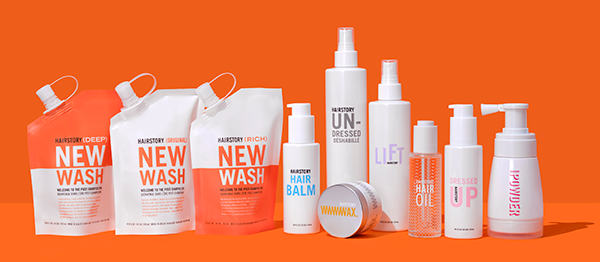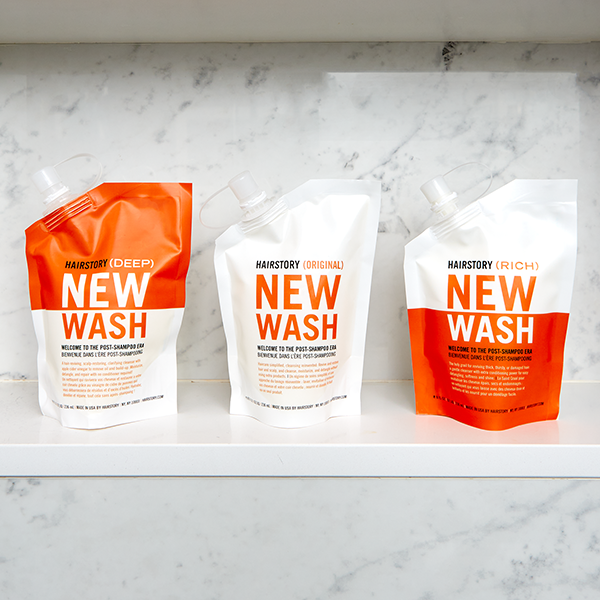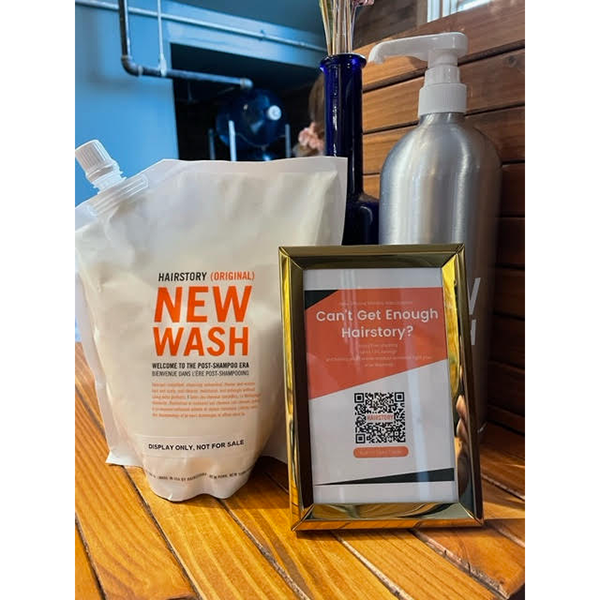How To Sell More Retail (Even On Amazon)
Stylists Can Make Money With Zero Retail Inventory: Here’s How
Prior to 2020, a lot of stylists didn’t love selling retail. But when salons had to close their doors over the past 2-ish years, product sales to clients helped many stylists pay their bills. Now, even if chairs are booked and stylists are busy, there’s still opportunity to bring in extra cash with retail sales. One company has figured out how to help stylists make passive income through retail sales commissions—even on Amazon sales—and we’re sharing how you can do it, too.
Created by former Bumble & bumble executives five years ago, Hairstory’s business model makes sure stylists get commission on retail sales—even sales made on Amazon—without having to carry any inventory. This year, Hairstory will pay $3 million in hairdresser commissions. Its hero product, New Wash, is a shampoo-free hair cleanser packaged in environmentally friendly pouches, instead of plastic bottles. (Get the scoop on New Wash’s push for a “shampoo-free future” here.)
Try New Wash for free: Click here

“Retail sales by hairdressers have plummeted because they’re busy running their own businesses and don’t have the capital to invest for a buy-in,” Hairstory CEO and Chairman Eli Halliwell told BTC in an exclusive interview.
That’s why the company developed a closed-system business model, where stylists earn commission on retail sales clients make online or in the salon, even with zero inventory on hand. It’s a way for clients to shop your salon 24 hours a day—while you sleep, work, hang with your family, whatever—while you get a commission. And they’ve figured out how to leverage the power of Amazon, not work against it.
As a result, hairdressers are making thousands of dollars per month with this business model—much more than they ever earned from traditional commission programs in salons. “Some stylists are making up to $8,000 a month with 25% commission, which is really, really generous,” said Lina Hussain, a Toronto-based haircutting specialist. “Not a lot of companies do that.”

The Retail Sales Decline: Social Media, Online Sales & Moving To Suites
As the former general manager of Bumble & bumble, Eli has been in the industry long enough to see a massive power shift. “Social media enabled the hairdresser to get the entire client list on their phone instead of the salon’s front computer,” he said.
With their client lists in hand, stylists opened their own suites. And in these small suites, they didn’t have the room, time or money to buy an entire retail line and sell it to clients who were used to the convenience of online shopping anyway. Plus, let’s be honest—stylists don’t want to sound like salespeople to the guests in their chairs.
Pro stylists: Get a free trial of New Wash
Meanwhile, hair care sales are rising. Unlike some categories like makeup, hair care remained resilient during the pandemic, according to Glossy. Prestige hair care holiday sales were up 51 percent year-over-year, even in a year where salons remained closed or had their business hours cut.
“We need to help hairdressers see that they can retail again,” Eli said. “It’s not hard and they can incorporate it back into what they can do—and increase profitably. Our number of hairdressers doubled over COVID, and the number of clients purchasing from hairdressers quadrupled over COVID.”

How a Closed-System Sales Model Works
The Hairstory system is set up so that once a client purchases a product and credits their stylist, whether online or in the stylist’s suite, that client is attached to that stylist for life. That means if the client buys a Hairstory product on the brand’s website or even on Amazon, the stylist will get 25% commission.
“It’s a way to make sure we’re always respecting the relationship between the hairdresser and client,” Eli said. That’s why the brand sells on Hairstory.com and Amazon, but not, for example, in Sephora. That way, Hairstory can see who is purchasing the product on Amazon to make sure the hairdresser gets the commission, versus someone walking into a Sephora and purchasing the product off the shelf.
Try New Wash for free & get to know Hairstory: Click here
This “perpetual affiliate model” gives hairdressers the opportunity to set up a passive income stream. A stylist can place a Hairstory link on their website and social media channels and put up a QR code to buy at their chair. Even if that client moves away, the stylist still gets credit for introducing the client to the brand, and continues to earn commission for any Hairstory purchases. Because Hairstory products are meant to be refilled, clients can sign up for monthly product refill subscriptions and don’t need to place an order every time they need product—it’s automatic.
“I love the fact that it’s passive income,” said April Kayganich, an independent stylist based in Austin, Texas. “I have my link on my social accounts and that helps me to earn commission even when I’m not working.”
View this post on Instagram
How To Sell Retail Without Carrying Lots of Product
Eli and his team know the future of hairdressing will continue to require flexibility, and they know online sales will never go away. Because of this, Hairstory doesn’t have a minimum order amount—in fact, you don’t even need to carry inventory. The Hairstory team works with stylists individually to create retail plans that align with their business goals.
“Nobody is doing this business model,” Eli said. “This makes it super accessible for booth renters, commission stylists and salon owners looking for new ways to retail. And the only way this is possible is by us not selling through retailers or distributors and you having a direct relationship with all of your clients.
With Hairstory’s model, clients who subscribe are twice as likely to repurchase—and stylists automatically receive a 25% commission every time a subscription order ships.
How To Get Over Retail Sales Anxiety
Stylists have always been shy about pushing retail sales with clients. “It’s an age-old barrier,” Eli said. “But you shouldn’t feel bad, because you’re helping the client recreate the look at home. That makes them look better, and makes your work look better.”
Plus, Hairstory takes the edge off the “hard sell.” With little to no physical product to sell in the salon, stylists can more easily plant the seed to buy.
“Say hey, this is what I used—if you want to use them in the future, here’s my link or QR code,” Eli said. “It eliminates the moment of, ‘Are you going to buy it?’ It diffuses it. Just say, ‘You get a discount if you use my code. Shipping is quick, in three to four days.’”
The nature of New Wash makes it an easy sell, Eli said. “Because New Wash is so crazy different, you can really explain why you like it,” he said. “For example, ‘My hands are soft and not chapped from detergent [like in traditional shampoo]. I am working a little harder to massage and rinse because there’s no foam.’”
Innovative products like New Wash will always be part of Hairstory’s DNA, because the brand understands that hairdressers only sell things they love and that they know actually work on their clients’ hair. This very fact, coupled with the company’s digital-first, closed system sales model, means your guests are getting the coolest and newest products on their terms—while you get the profit. Interested in learning more? Get a free sample of New Wash and connect with Hairstory.
BTC Free Trial: Try Hairstory New Wash Now

This content is sponsored.







